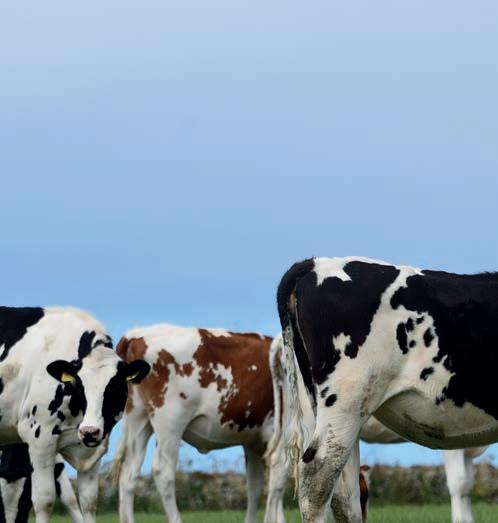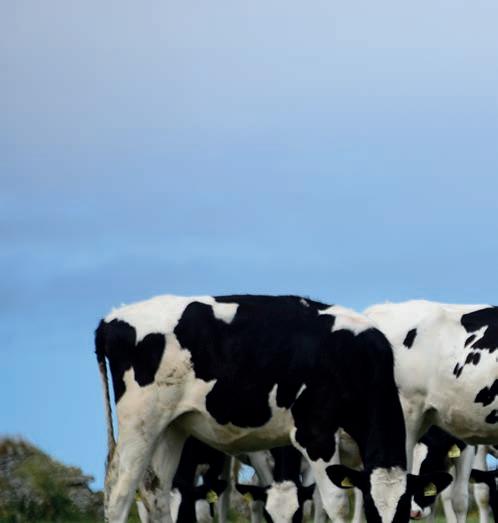
7 minute read
SUSTAINABILITY
Pembrokeshire dairy farmer Geoff Lewis has taken several measures to secure his business for the future, including the installation of robot milkers for his high-yielding herd and a new slurry store. Wendy Short reports.
Geo Lewis is the h generation at Pearson Farm, Haverfordwest, which he manages in partnership with his mother Mary and wife Lucy.
As part of an ongoing improvement programme, the family moved from twice-a-day milking to the installation of ve robots in 2019.
He estimates that the new system has increased yields by about 2,000kg/head for his 300-cow fully housed herd, which is registered under the St Brides Holstein pre x. e herd lactation average, including heifers, is 10,900kg, at 4.1% fat and 3.35% protein, with all-year-round calving and milk sold to a local supplier.
Most buildings have been modernised over the years and the dairy housing includes a set of roomy cubicles, auto-scrapers and LED lighting. e switch was carried out in two stages, prior to the sale of the 20:40 swing-over parlour. Mr Lewis says: “It was fortunate that the building design allowed for a straightforward transition to robots. e rst three installations went in while 100 cows carried on being milked through the parlour and the remaining robots were brought in to use in a di erent area a week later.
“Nobody got much sleep that week, but overall the process went smoothly. It took about three weeks for the cows to get used to the routine. We had looked at a number of robotic systems before deciding upon the Fullwood Merlin.
“ e robots have changed the working pa ern, but like all livestock farmers, our job is a 24-hour, seven days-a-week commitment.
“If there is a problem, we are alerted via our mobile phones and that can occasionally occur overnight. With a high-yielding herd, we cannot a ord to have a machine out of action for any length of time.”
While the farm no longer requires relief milkers, the sta ng requirement has otherwise remained unchanged, with a herdsman and three full-time employees. One sta member is dedicated to the maintenance of the robots and making sure the cows are being milked e ectively.
Heifers and fresh calvers are kept in an adjacent pen for the week post-calving, so they become accustomed to using the system.
Concentrates are fed to yield in the robots, while the herd’s total mixed ration (TMR) contains a wide range of feedstu s, with maize making up 50% of the forage inclusion, along with grass silage.
Other ingredients include 1kg
Planning ahead for a sustainable business
Maize has been grown at Pearson Farm for the past two decades. PICTURES : Ruth Rees Photography Left to right: Dylan, Geoff, Lucy, Ffion and Megan Lewis.

AGRICULTURAL & INDUSTRIAL STEEL FRAMED BUILDINGS
Livestock Housing, Crop Storage, Industrial & Commercial, Tip Troughs Schurr Cow Brushes

NEW
ELECTRIC ASK FOR DETAILS NOW AVAILABLE
BEDDING MACHINES
Scrape, Sweep and Spread in one pass. Bedding Material and Labour saving. Reduce cell count and increase production. Prevent disease and maintain good animal Health. Self-loading models available. Simple to drive and manoeuvre. 1 or 3 wheel drive.
www.rebuildings.co.uk

of chopped wheat straw, 1kg of molasses, a three-way blend containing soya, rape and sugar beet, plus an omega 3 supplement, yeast and minerals.
Rolled barley is fed separately through an auger bucket at 2kg/ head, to encourage the cows to leave their cubicles in order to simplify bedding down.
Maize has been grown at Pearson Farm for the past two decades, with 48 hectares (120 acres) allocated to the crop this year.
Mr Lewis says: “ e 2021 maize crop was successful in terms of both yield and quality and the 2022 acreage has been increased to ensure a 12-month supply. ere was a two-month shortage last year and yields fell by 1.5-2kg/head, along with a dip in fertility which occurred almost immediately. e dung consistency was loose, providing a visual indicator of the importance of maize in the diet. All of these issues were recti ed when maize silage was re-introduced to the ration.”
Mr Lewis has grown KWS Artikus for the past two seasons. It has an FAO, or maturity rating, of 160, which puts it in the ultra-early category. However, the variety has been superseded and KWS Exelon has been sown this year.
Maize silage and the concentrate
Farm facts
rThe farm comprises 354 hectares (875 acres) of owned and rented land rMost of the soil is a free-draining, fairly fertile red sandstone rThe aim is to calve heifers at 24 months rThe calving interval runs at 420 days; the high-yielding cows are not pushed hard for fertility during early lactation





The cubicle shed is fitted with auto-scrapers and LED lighting. Maize makes up 50% of the herd’s TMR along with grass silage.

blend are omi ed from the TMR until 4pm in winter, because they a ract starlings in large numbers, Mr Lewis says. ey are added once the birds have gone to roost.
He says: “ e Artikus variety yielded 18 tonnes/acre fresh weight and achieved a starch gure of about 33%. As it was very mature, it was not the easiest crop to roll in the clamp. Nevertheless, it would have still been our rst choice for this year, had it been available.
“I am con dent that Exelon will produce similar, or even be er, results. e variety has performed well on my brother-in-law’s farm nearby. It is an early variety, which is important because our harvest deadline is the date when clocks turn back in autumn.
“If maize is cut any later, the soil will not dry out su ciently and there will be a risk of compaction problems with the following crop.
“KWS Exelon has the potential to carry a higher number of grain rings compared with its predecessors and its cobs are positioned close to the ground to o set the risk of lodging.
“Fields are favourable for maize-growing and I would classify the land as early. e usual planting date is the end of April/beginning of May and although the cold spring of 2021 delayed sowing, the crop managed to catch up.” e standard rotation is to follow the maize with three- or four-year grass leys, followed by potatoes, then cereals for a couple of years before returning to maize. e soil pH is brought to 6.5 before maize seedbed preparation, which uses the plough and a Teagle multi-disc, one-pass cultivator.
It is followed by a combination power harrow with the drill element removed to produce a ne seedbed which will be sown at a 75cm row width.
In the past, maize seed has been planted to a depth of 5cm, but advice to plant at 7cm last season to establish a secure root was followed and the practice worked well.
DIY arti cial insemination (AI) from mostly genomic sires is used extensively, with 75% made up of sexed semen. ‘Robot-ready’ bulls are preferred, as they pass on high-scoring udder conformation. ere is also a Holstein sweeper bull for serving heifers and repeat cows a er three or four AI services.
Sadly, the herd is under TB restrictions and therefore all beef ca le are nished and sold deadweight. British Blue and Aberdeen-Angus AI sires are used on the lower 30% of the herd.

Excellent match
“ e British Blue is an excellent match for our type of Holstein cow for beef calves, but the Aberdeen-Angus is useful for second calvers due to its easy-calving qualities.
“About 80 head are nished each year, achieving pleasing weights on a simple system of grass silage and up to 8kg/head of Maxammon-treated barley.”
A new slurry lagoon was built in 2021, in anticipation of a tightening of Nitrate Vulnerable Zone regulations in Wales. e next project is to install a larger bulk tank for potential alternate-day milk collection and this will also help to reduce the farm’s carbon footprint, Mr Lewis says. e unit is situated in an isolated location and the additional tank should increase milk marketing exibility.
Mr Lewis has no regrets about switching to robotic milking and feels the family has done as much as nances permit to ‘future-proof ’ the business.
He says: “We are fully commi ed to milk production and we have invested in modernising our business. e milk price is going in the right direction and I feel we have turned a corner a er a long period in the doldrums.
“However, the price trend will have to continue if we are to absorb the alarming rise in fuel and fertiliser costs the industry has recently been experiencing.”














